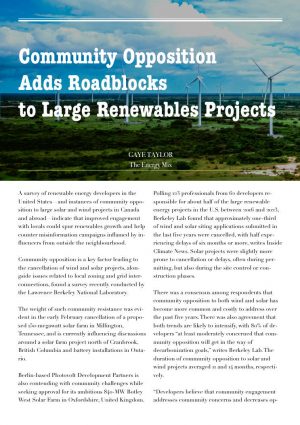 A survey of renewable energy developers in the United States—and instances of community opposition to large solar and wind projects in Canada and abroad—indicate that improved engagement with locals could spur renewables growth and help counter misinformation campaigns inflamed by influencers from outside the neighbourhood.
A survey of renewable energy developers in the United States—and instances of community opposition to large solar and wind projects in Canada and abroad—indicate that improved engagement with locals could spur renewables growth and help counter misinformation campaigns inflamed by influencers from outside the neighbourhood.
Community opposition is a key factor leading to the cancellation of wind and solar projects, alongside issues related to local zoning and grid interconnections, found a survey recently conducted by the Lawrence Berkeley National Laboratory.
The weight of such community resistance was evident in the early February cancellation of a proposed 150-megawatt solar farm in Millington, Tennessee, and is currently influencing discussions around a solar farm project north of Cranbrook, British Columbia and battery installations in Ontario. Berlin-based Photovolt Development Partners is also contending with community challenges while seeking approval for its ambitious 840-MW Botley West Solar Farm in Oxfordshire, United Kingdom.
Polling 123 professionals from 62 developers responsible for about half of the large renewable energy projects in the U.S. between 2016 and 2023, Berkeley Lab found that approximately one-third of wind and solar siting applications submitted in the last five years were cancelled, with half experiencing delays of six months or more, writes Inside Climate News. Solar projects were slightly more prone to cancellation or delays, often during permitting, but also during the site control or construction phases.
There was a consensus among respondents that community opposition to both wind and solar has become more common and costly to address over the past five years. There was also agreement that both trends are likely to intensify, with 80% of developers “at least moderately concerned that community opposition will get in the way of decarbonization goals,” writes Berkeley Lab. The duration of community opposition to solar and wind projects averaged 11 and 14 months, respectively.
“Developers believe that community engagement addresses community concerns and decreases opposition,” the lab found. “Most agree that increased engagement results in fewer project cancellations (75%) and local concerns are adequately addressed before project construction (66%).”
Asked to reflect on the latest cancelled project they had worked on, most respondents indicated that earlier engagement would have been a good idea.” However, a few said “early engagement allowed opposition to form, which ultimately led to cancellation.”
Opposition ‘Driven by Outsiders’
Berkeley Lab’s survey found “the vast majority” of respondents, about 95%, reporting that community opposition is “often caused by a vocal minority.” About half said those voices may not be local, with community opposition being “more often driven by outsiders.”
Groups like the Washington, D.C.-based Citizens for Responsible Solar, led by well-connected political operative Susan Ralston, exemplify external efforts to undermine renewable projects across multiple U.S. states. The organization has been fought solar projects in coal-producing Kentucky, Ohio, Pennsylvania, and Virginia, National Public Radio found in a news investigation last February.
Citizens for Responsible Solar seems to be a well-mobilized “national effort to foment local opposition to renewable energy,” Michael Burger, executive director of the Sabin Center for Climate Change Law at Columbia University, told NPR. “What that reflects is the unfortunate politicization of climate change, the politicization of energy, and, unfortunately, the political nature of the energy transition, which is really just a necessary response to an environmental reality.”
NPR writes that when Ralston was creating the organization, she consulted people like John Droz—a longtime critic of the wind industry and member of the CO2 Coalition, a non-profit supported by fossil fuel magnate Charles Koch. A number of the concerns Droz raises about wind are echoed on the Citizens for Responsible Solar website, NPR says. The material is “extremely misleading and appears designed to be misinformation,” according to Ronald Meyers, director of the Renewable Energy Facility Siting project at Virginia Tech.
“Responsible Solar” activist groups have also popped up in Kansas—much to the chagrin of two Kansas farmers fighting for permits to build a solar farm on family land—and Iowa.
Groups like that “are operating from the same playbook featuring shared materials and draft petitions from national sources that originate thousands of miles from Iowa,” reports NPR, citing Ray Gaesser, chair of the Iowa Conservative Energy Forum, which fights for renewables projects on economic grounds. “Their mission is to kill new development, not to help develop common-sense ordinances,” Gaesser says.
Bright, Red Posters
Over in Oxfordshire, some opponents of Botley West are circulating bright, red posters declaring that the solar farm is “Russia-owned” and therefore in breach of the international sanctions imposed after Vladimir Putin’s invasion of Ukraine. Project director Mark Owen-Lloyd rejects the claim, and is promising to make all investment sources clear in the project planning application due in June.
Meanwhile, Botley West developer Photovolt has begun pushing back against claims of a failure to consult, instructing its PR firm, DRD Partnership, to engage in email outreach with climate solutions journalists.
In one recent email, DRD senior associate Anna Cacciaguerra Ranghieri described the “vocal and fierce” opposition to Botley West as a bellwether for what awaits large renewables projects across the country. “We can expect to see more of this as the UK produces the scale of development needed to reach our net-zero goals,” she wrote, describing a pattern of broad acceptance of renewables in principle, followed by a loud objection to having utility-scale projects anywhere in sight.
Concerns about the visual impacts of renewables constitute the “single largest objection” to new projects, according to data gathered by Photovolt during its consultation with Oxfordshire residents, Ranghieri said. Her assertion echoes the Berkeley Lab’s findings: “Developers report visual concerns to be the most likely root cause of community opposition for both wind and solar. Other leading concerns for wind are sound, community character, and property values, and for solar are loss of agricultural land, community character, and property values.”
The Energy Mix asked Ranghieri about claims made by the chair of the Stop Botley West Community Group that consultation has been “shamefully inadequate.” She responded with a statement from Owen-Lloyd that Photovolt is “deeply committed to consultation with local residents.”
“We recently conducted our second, rigorous 10-week consultation process in tandem with the community that has significantly surpassed the standard regulatory requirements typically set for a 28-day consultation period,” Owen-Lloyd said.
“We worked closely with the community in all cases, with certain consultation meetings arranged at locations that were not required, but requested by local people or a local planning authority,” he added.
But there are signs that the fate of Botley West is now out of the hands of local residents. The West Oxfordshire District Council had some influence, and managed to get Photovolt’s agreement on increased setbacks, a community benefit fund, and discounted electricity prices. But the solar farm is being treated as a national infrastructure project due to its size—so its ultimate fate rests with the UK Planning Inspectorate, noted the West Oxfordshire Green Party.
The Costs—and Rewards—of Engagement
Around 65% of solar developers and 55% of wind developers told Berkeley Lab they are “spending more to address and mitigate community opposition than five years ago.”
Even so, “typical community engagement expenditures represent a small fraction of total capital expenditures for both wind and solar,” Berkeley Lab notes. And besides, whatever the cause, “project cancellations result in average sunk costs (expenses spent on the project that could not be recovered) of more than US$2 million per project for solar, and $7.5 million for wind.”
A brewing battle in the forested grasslands north of Cranbrook shows how outreach is crucial for conveying key facts to the community.
Just north of the city, Vancouver-based Enterprise Renewables is working to secure a permit to survey a 50-square-kilometre swath of rangeland and forest to determine the best location for a proposed two-square-kilometre solar farm.
But at least one irate letter writer—a local resident—has concluded that Enterprise intends to build across the entire survey area—an ambition that would leave Botley West looking like a cricket pitch.
“If this farm, if one can even call it that, moves forward, it would destroy the forest with clearcutting and chemically wipe out all grass and vegetation, making the land look like a nuclear blast site,” writes the concerned citizen. Such hyperbolic and misconceived claims show that work remains to be done to bring onside local communities, especially rural ones whose connection to the land is so visceral.
Gaye Taylor
Originally published
by Energy Mix
March 7, 2024


